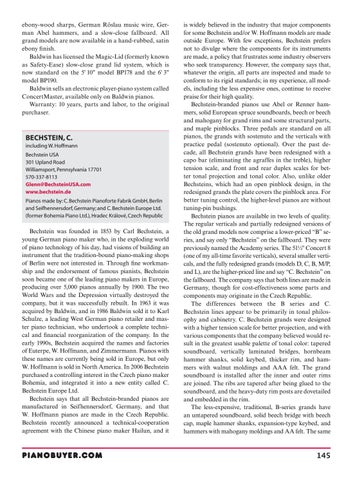ebony-wood sharps, German Röslau music wire, German Abel hammers, and a slow-close fallboard. All grand models are now available in a hand-rubbed, satin ebony finish. Baldwin has licensed the Magic-Lid (formerly known as Safety-Ease) slow-close grand lid system, which is now standard on the 5' 10" model BP178 and the 6' 3" model BP190. Baldwin sells an electronic player-piano system called ConcertMaster, available only on Baldwin pianos. Warranty: 10 years, parts and labor, to the original purchaser.
BECHSTEIN, C. including W. Hoffmann Bechstein USA 301 Upland Road Williamsport, Pennsylvania 17701 570-337-8113 Glenn@BechsteinUSA.com www.bechstein.de Pianos made by: C. Bechstein Pianoforte Fabrik GmbH, Berlin and Seifhennersdorf, Germany; and C. Bechstein Europe Ltd. (former Bohemia Piano Ltd.), Hradec Králové, Czech Republic
Bechstein was founded in 1853 by Carl Bechstein, a young German piano maker who, in the exploding world of piano technology of his day, had visions of building an instrument that the tradition-bound piano-making shops of Berlin were not interested in. Through fine workmanship and the endorsement of famous pianists, Bechstein soon became one of the leading piano makers in Europe, producing over 5,000 pianos annually by 1900. The two World Wars and the Depression virtually destroyed the company, but it was successfully rebuilt. In 1963 it was acquired by Baldwin, and in 1986 Baldwin sold it to Karl Schulze, a leading West German piano retailer and master piano technician, who undertook a complete technical and financial reorganization of the company. In the early 1990s, Bechstein acquired the names and factories of Euterpe, W. Hoffmann, and Zimmermann. Pianos with these names are currently being sold in Europe, but only W. Hoffmann is sold in North America. In 2006 Bechstein purchased a controlling interest in the Czech piano maker Bohemia, and integrated it into a new entity called C. Bechstein Europe Ltd. Bechstein says that all Bechstein-branded pianos are manufactured in Seifhennersdorf, Germany, and that W. Hoffmann pianos are made in the Czech Republic. Bechstein recently announced a technical-cooperation agreement with the Chinese piano maker Hailun, and it
PIANOBUYER.COM
is widely believed in the industry that major components for some Bechstein and/or W. Hoffmann models are made outside Europe. With few exceptions, Bechstein prefers not to divulge where the components for its instruments are made, a policy that frustrates some industry observers who seek transparency. However, the company says that, whatever the origin, all parts are inspected and made to conform to its rigid standards; in my experience, all models, including the less expensive ones, continue to receive praise for their high quality. Bechstein-branded pianos use Abel or Renner hammers, solid European spruce soundboards, beech or beech and mahogany for grand rims and some structural parts, and maple pinblocks. Three pedals are standard on all pianos, the grands with sostenuto and the verticals with practice pedal (sostenuto optional). Over the past decade, all Bechstein grands have been redesigned with a capo bar (eliminating the agraffes in the treble), higher tension scale, and front and rear duplex scales for better tonal projection and tonal color. Also, unlike older Bechsteins, which had an open pinblock design, in the redesigned grands the plate covers the pinblock area. For better tuning control, the higher-level pianos are without tuning-pin bushings. Bechstein pianos are available in two levels of quality. The regular verticals and partially redesigned versions of the old grand models now comprise a lower-priced “B” series, and say only “Bechstein” on the fallboard. They were previously named the Academy series. The 51½" Concert 8 (one of my all-time favorite verticals), several smaller verticals, and the fully redesigned grands (models D, C, B, M/P, and L), are the higher-priced line and say “C. Bechstein” on the fallboard. The company says that both lines are made in Germany, though for cost-effectiveness some parts and components may originate in the Czech Republic. The differences between the B series and C. Bechstein lines appear to be primarily in tonal philosophy and cabinetry. C. Bechstein grands were designed with a higher tension scale for better projection, and with various components that the company believed would result in the greatest usable palette of tonal color: tapered soundboard, vertically laminated bridges, hornbeam hammer shanks, solid keybed, thicker rim, and hammers with walnut moldings and AAA felt. The grand soundboard is installed after the inner and outer rims are joined. The ribs are tapered after being glued to the soundboard, and the heavy-duty rim posts are dovetailed and embedded in the rim. The less-expensive, traditional, B-series grands have an untapered soundboard, solid beech bridge with beech cap, maple hammer shanks, expansion-type keybed, and hammers with mahogany moldings and AA felt. The same
145
